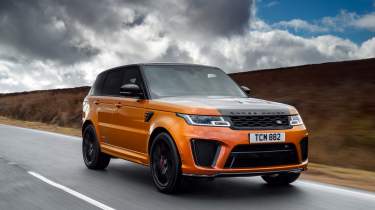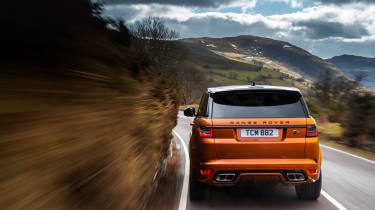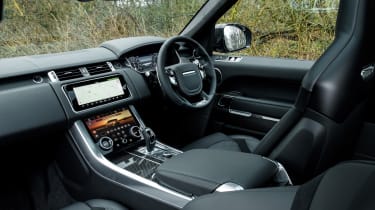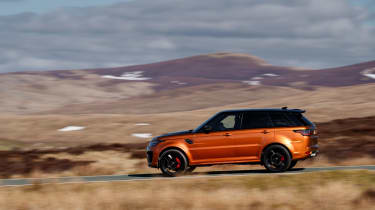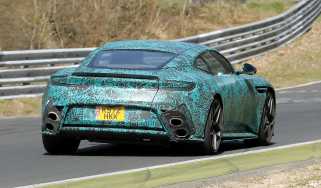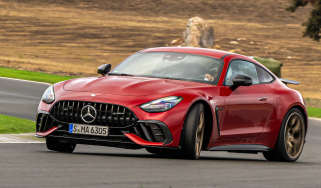Range Rover Sport SVR (2014-2022) review – Land Rover's big bold hot rod SUV
The Range Rover SVR was impressively capable on road and off it, but not a car for those wishing to keep a low profile
The Range Rover Sport SVR was the first car to emerge from JLR’s Special Vehicle Operations (SVO) division, and while a 2.3-ton SUV might not have been a natural choice on which to demonstrate SVO’s abilities, it was certainly an impressive statement of intent.
The updated car enjoyed a series of updates rolled out across the Range Rover Sport lineup, plus a few of its own besides - not least a power boost, some chassis revisions and a selection of visual alterations.
Engine, performance and 0-60mph time
The SVR uses JLR’s supercharged 5-litre V8, developing a Jaguar XJR 575-matching 567bhp and 517lb ft of torque in updated form. The earlier SVR managed 542bhp and 502lb ft.
An eight-speed automatic transmission is standard and naturally, power is sent to all four wheels - 21-inch rims were standard, with a 22-inch design optionally available. Braking is by 380mm ventilated discs up front and 365mm ventilated discs astern.
In performance terms the upshot of the power boost was a couple of tenths shaved from the 0-60mph time, down to 4.3sec from 4.5 (taking 4.5sec to get to 62mph) and a generous top speed of 174mph.
Technical highlights
SVO adorned the updated Range Rover SVR with a full carbonfibre bonnet with the update, which was also available fully painted, as well as in the two-tone colourway pictured. While no weight benefit was quoted directly, the SVR’s kerb weight dropped to 2310kg by 25kg, compared to earlier cars. The SVO team's search for weight savings moved elsewhere too (and possibly weight gains in a few areas) – the seats, for instance, were 30kg lighter in the facelifted SVR.
More reviews
Reviews
Engineers also altered the suspension settings, in particular the damping (SVRs use air springs, active dampers and active anti-roll bars at both ends) in order to control pitch under heavy acceleration and braking, while improvements in turn-in, body control and mid-corner grip are also claimed.
Inside, all updated Range Rovers got Velar-sourced, Touch Pro Duo 10in touchscreens in the centre console, which feel a lot more modern than the systems they replaced.
What’s it like to drive?
Without driving both SVRs back to back it’s difficult to determine whether the SVO team’s tweaks made a considerable difference to the way the car drives, but it's impressively engaging for a car that weighs around twice as much as a Peugeot 208 GTi.
There’s a firmness to the SVR’s ride quality but it stops short of being uncomfortable, even with the SVR containing firmer sports seats than other Range Rover Sports. And the tradeoff is taut body control, which in turn benefits the surprisingly responsive steering, adding-up to a car that, if driven smoothly and on wide enough roads, can be bundled along at quite a pace.
Physics will win out eventually in a car of this size and weight, so as we found with the previous SVR, it’s best to be measured in your inputs. Accelerating, braking or steering harshly can induce unwanted body movements and begin to trouble the stability control, but driven smoothly you can really lean on the grip available and make the most of the thunderous pace on hand.
Ah yes, that engine. It’s loud and cacophonous, and when you're sharing the roads with others it's difficult not to feel like you're a bit of a nuisance in your “Madagascar Orange” two-tonne SUV with an exhaust note like the Corvettes at Le Mans.
Conversely, if you don’t giggle like a schoolchild the first (or even the tenth) time you roar up and down the gears or lift-off to a fusillade of pops and bangs from the four oblong tailpipes, then you must have a heart of stone. It's a car of contrasts, which makes it interesting, and that makes it worthwhile for us.
The way the SVR moves is quite remarkable too, and it does so with a great deal more theatre than its German rivals. SVO might have tweaked the dampers for less pitch but the nose still rises like the bow of a powerboat when you stand on the throttle and the steering still goes light in your hands. It’s rowdy, hilarious and exciting, and it’s hard to imagine such a car being socially acceptable much longer, so enjoy the unique thrill while it lasts.
Prices, rivals and buying guide
The Range Rover Sport SVR might have been a performance model but it depreciated like any other ageing Range Rover. Leggy (80k-mile and over) early cars can be had in the mid-£20k Range, while the newest Carbon Edition cars are still up in the mid-£70k range. Though caution should be stressed with any used Range Rover purchase, the supercharged V8 is considered relatively reliable. Do have a good look at all the toys and check the suspension is working as it should. Good service and MOT history should be a given, and check for a history of theft and the consumables (brakes and tyres) too.
The SVR's closest rivals in terms of size, price point and ethos are all German, though in terms of performance SUVs as a whole Alfa Romeo's Stelvio Quadrifoglio is quicker off the mark (0-62mph in 3.8sec). Those Germans are the Porsche Cayenne Turbo , the BMW X5M and the Mercedes-AMG GLE 63 S.
All offer broadly similar performance (in numerical terms at least) and are similarly priced even on the used market. The Range Rover has the edge in terms of character and theatre and should show the others a dirty pair of wellies off-road too – a brief jaunt on the launch when new suggested the SVR is incredibly capable in the rough even on road-biased tyres. A Cayenne Turbo of the same era probably has the edge on the road.

